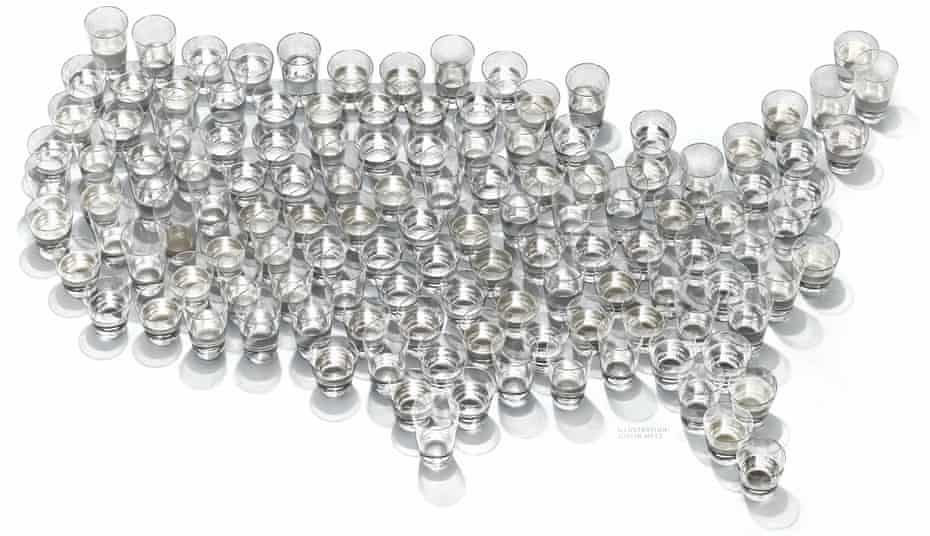We sampled tap water across the US – and found arsenic, lead and toxic chemicals

In a nine-month investigation by the Guardian and Consumer Reports we found forever chemicals, arsenic and lead in samples taken across the US
Last modified on Wed 31 Mar 2021 07.11 EDT
In Connecticut, a condo had lead in its drinking water at levels more than double what the federal government deems acceptable. At a church in North Carolina, the water was contaminated with extremely high levels of potentially toxic PFAS chemicals ( a group of compounds found in hundreds of household products). The water flowing into a Texas home had both – and concerning amounts of arsenic too.
All three were among locations that had water tested as part of a nine-month investigation by Consumer Reports (CR) and the Guardian into the US’s drinking water.
Since the passage of the Clean Water Act in 1972, access to safe water for all Americans has been a US government goal. Yet millions of people continue to face serious water quality problems because of contamination, deteriorating infrastructure, and inadequate treatment at water plants.
CR and the Guardian selected 120 people from around the US, out of a pool of more than 6,000 volunteers, to test for arsenic, lead, PFAS (per- and polyfluoroalkyl substances), and other contaminants. The samples came from water systems that together service more than 19 million people.
A total of 118 of the 120 samples had concerning levels of PFAS or arsenic above CR’s recommended maximum, or detectable amounts of lead. Testing of the samples showed:
More than 35% of the samples had PFAS, potentially toxic “forever chemicals”, at levels above CR’s recommended maximum.
About 8% of samples had arsenic, at levels above CR’s recommended maximum.
In total, 118 out of 120 samples had detectable levels of lead.
The study has some limitations: the quality of the water at one location on a single day doesn’t necessarily reflect the quality of the water supplied by an entire system or at other times. But the ambitious undertaking, with community water systems chosen by CR’s statisticians from a representative mix of systems across the country, provides a unique view into some of the most significant challenges in America’s ongoing drinking water crisis.
Almost every sample tested had measurable levels of PFAS, a group of compounds found in hundreds of household products. These chemicals are linked to learning delays in children, cancer, and other health problems. More than 35 percent exceeded a safety threshold that CR scientists and other health experts believe should be the maximum.
Yet many consumers have never heard of PFAS.
Hung Ng, a resident of Florida, New York, says he has long used home water filters, in part to remove lead. But the 69-year-old says he didn’t know anything about PFAS until he had his water tested as part of this investigation, which found comparatively high levels of the chemicals in his water. “Now I’ve got to find something to filter out the PFAS,” Ng says.
The tests revealed other problems as well. About 8% of samples had levels of arsenic – which gets into drinking water through natural deposits or industrial or agricultural pollution – above CR’s recommended maximum for drinking water. And almost every sample had measurable amounts of lead, a heavy metal that leaches from corroding water lines and home plumbing fixtures. It is unsafe at any level.
In response to the findings, Environmental Protection Agency spokesperson Andrea Drinkard says that 93% of the population supplied by community water systems gets water that meets “all health-based standards all of the time” and that the agency has set standards for more than 90 contaminants. That includes arsenic and lead but does not include PFAS.
America’s water crisis, while widespread, affects some communities more than others, according to an analysis of more than 140,000 public water systemspublished by the Guardian in February. It found that access to clean drinking water is highly unequal in the US, with water systems that service poorer and rural counties far more likely to have violations than those that provide water to wealthier or urban ones. Water systems in counties with large Latino populations were particularly likely to have violations, the Guardian found.
PFAS: the ‘forever chemical’ problem
The PFAS results from CR’s tests are particularly troubling.
Manufacturers use PFAS to make stain-resistant fabrics and carpets, water-repellent clothing, nonstick cookware, and hundreds of other common products. The compounds can seep into water from factories, landfills, and other sources. And because they don’t easily break down in the environment, they’re often called “forever chemicals”.
Investigation into the health effects of PFAS exposure is ongoing, but some of the strongest evidence about their potential risks comes from research of about 69,000 people in and around Parkersburg, W Va. The research – part of a settlement between DuPont, which makes some PFAS, and residents of the community – was depicted in the 2019 movie Dark Waters.
It found a “probable link” between exposure to a type of PFAS and six health problems: high cholesterol, ulcerative colitis, thyroid disease, pregnancy-induced hypertension, and testicular and kidney cancers. Research has also linked some PFAS to learning delays in children.
At least 2,337 communities in 49 states have drinking water known to be contaminated with PFAS, according to a January analysis by the Environmental Working Group (EWG), an advocacy organization.
CR’s tests results confirm the ubiquity of the chemicals: We found PFAS in 117 of the 120 samples we tested, from locations across the country.
Despite mounting evidence of widespread contamination and health risks, the EPA has still not set an enforceable legal limit for PFAS in drinking water. Instead, it has established only voluntary limits, which apply to just two of the better-studied forever chemicals–PFOA, or perfluorooctanoic acid, and PFOS, or perfluorooctanesulfonic acid–at 70 parts per trillion combined.
Harvard environmental health professor Philippe Grandjean has suggested that the limit should be just 1 ppt for PFOA and PFOS, citing his 2013 research– partly funded by the EPA – showing decreased vaccine response in children exposed to the chemicals.
CR’s scientists say the maximum allowed amount should be 5 ppt for a single PFAS chemical and 10 ppt for two or more.Among the 120 samples CR tested, more than a third had PFAS levels above 10 ppt, and more than a quarter exceeded 5 ppt for a single PFAS chemical.
Two samples had PFAS levels above the federal advisory level of 70 ppt, with the highest amount – 80.2 ppt–coming from a sample that Jim Vaughn, a 76-year-old retired electrical equipment salesman, collected at his church in Pittsboro, NC.
Vaughn wasn’t particularly surprised, he says. Places such as Pittsboro–a community of about 6,700 on the fringes of North Carolina’s Research Triangle, which is anchored by three universities and filled with industry and high-tech business – are used to getting “dumped on,” he says. “It’s that little feeling of helplessness. Is there something that the town will do about it? Or will we let it ride?”
Indeed, residents of Pittsboro have reason to worry, beyond the results of CR’s tests. In 2007, an EPA study found PFAS contamination in the Cape Fear River Basin, a major source of drinking water for the eastern half of North Carolina. Some of the highest levels came from the Haw River in the basin’s north end – where Pittsboro gets its water.
Ongoing research out of Duke University, in nearby Durham, has also raised concerns. It found that levels of PFAS in a study of 49 Pittsboro residents’ blood are two to four times higher than that of the general US population. Heather Stapleton, the project’s lead investigator, says Vaughn’s test results align with her team’s findings.

“If you think about the number of communities that could be impacted, it’s close to a million people,” she says.
Chris Kennedy, town manager for Pittsboro, says the town was not a source of PFAS but that it was “diligently working towards removing PFAS from our potable water supply”. He adds that the town is installing filters at the water treatment plant to remove at least 90% of PFAS by the end of 2021 and is taking steps “to reduce contamination into the Haw River, which will provide the best results long term”.
Arsenic: a toxin in the water
More than 1,200 miles away from Pittsboro, Sandy and Scott Phillips sat around their kitchen table in Texas on a weekday in February reflecting on the test results for their water samples.
Last year, looking to downsize, they built the custom home of their dreams in a new development in Round Rock, 20 miles north of Austin.
But soon after moving in, they began to notice the water had an unusual odor, prompting them to invest thousands in a water softening and reverse osmosis water filtration system.
Not long after, the couple got their water tested as part of CR’s project, taking samples from water before it was filtered. The results were concerning: high not just in PFAS (32.8 ppt) but also in arsenic, at 3.3 parts per billion. “We get this gorgeous house,” Sandy Phillips says, “and then the water is terrible.”
Bill Brown, general manager of the Jonah Water Special Utility District, the couple’s water supplier, says it “has complied with all federal and state minimum contaminant level standards for arsenic and lead for many years”. He says that while CR’s results conflicted with its records, the water district will investigate. He did not comment on the PFAS found in the Phillipses’ water.
In the early 2000s, the EPA considered a drinking water limit for arsenic of 3 ppb, before settling on 10 ppb as an amount that balances the costs for water system operators while reducing health risks. CR scientists have long said the EPA should set a limit of 3 ppb or lower, in line with what other health experts and environmental advocacy groups, such as the Natural Resources Defense Council (NRDC), have called for.
Almost every sample CR tested had measurable levels of arsenic, including 10–or about 8 percent–with levels between 3 and 10 ppb. Previous tests from CR and others have shown elevated levels in juices and baby foods.
Research suggests that exposure to even low levels of arsenic can pose health risks over the long term. A 2014 study in the journal Environmental Health found an association between water with arsenic of 5 ppb or greater and a five- to six-point IQ reduction in children.
Two states–New Hampshire and New Jersey–have lowered their arsenic limit to 5 ppb, citing warnings from studies. The EPA itself even sets its “maximum contaminant level goal”–the level below which there is no known or expected risk to health–at zero for arsenic.
Lead: no safe amount
The Phillipses, in Texas, were especially fortunate to have installed a filtration system because the results of their unfiltered tap test showed high levels of not only arsenic but also lead, at 5.8 ppb. (CR’s follow-up tests of the couple’s filtered water showed trace amounts of lead and levels of arsenic and PFAS well within CR’s recommended limits.)
The risks of lead, and problems with how water utilities test for it, became a national concern when news of the water crisis in Flint, Mich., exploded in 2015. Scientists and the EPA agree that there’s no safe exposure level of lead. But taking into consideration the feasibility of achieving lower levels, the EPA says utilities have to take significant steps to lower lead levels – including replacing lead service lines – only when 10% of samples from homes in their service areas exceed 15 ppb.
Consumer advocates say those EPA regulations are problematic – a reality underscored by the testing results of water being piped into a condo owned by Stephen and Robin Newberg in New Britain, Connecticut.
Lead typically works its way into drinking water through lead pipes that feed people’s homes or in the home’s plumbing itself.
While New Britain’s annual water quality report for customers indicates that its average lead level is 6 ppb, the Newbergs’ results showed a concentration of 31.2 ppb, more than double the EPA’s action level of 15 ppb.
Stephen Newberg, a former postal worker, says he drinks filtered water and his wife drinks bottled water, so he’s not personally worried. But the 66-year-old sits on the board of his condo, and he’s concerned about the possibility of the heavy metal being in his neighbors’ water.
Ramon Esponda, New Britain’s deputy director of public works, says that the city complies with the EPA’s lead regulations, based on its 2020 tests, which found an average lead level of 2 ppb. Esponda says that results of a single sample may be thrown off by new fixtures, recent plumbing work, or other factors.
The installation of new lead service lines – pipes that connect a water main in a street to individual buildings – was banned in 1986. But an estimated 3 million to 6 million homes and businesses nationwide still get water through older lines that contain lead, according to EPA estimates. An untold number of homes have plumbing fixtures made of the heavy metal. Exposure can especially pose risks in children, such as reduced IQ and behavioral problems.
The Newbergs’ results were the only ones in CR’s tests to be above the EPA action level. But almost every sample had measurable levels of lead, and health experts emphasize that no amount of lead is safe.
Erik Olson, senior strategic director of health and food at the NRDC, says the Newbergs’ results illustrate several problems with how the EPA regulates lead. One is that water systems typically test for lead only once every three years, and larger systems can get waivers to test every nine years. Another is that the sample sizes are generally small.
“There’s very little oversight, and they may not be testing the highest-risk homes,” Olson says.
The EPA, in the waning days of the Trump administration, finalized changes to the lead regulation that would require testing in elementary schools and established new rules regarding the steps water systems must take when lead is detected.
But the NRDC, the NAACP, and other groups recently sued the EPA, saying those steps didn’t go far enough, and urged the Biden administration to improve on them.
Solutions
People seeking cleaner drinking water do have some options for reducing their exposure to dangerous contaminants. But consumer advocates say that fixing the problem shouldn’t be up to consumers.
“Americans shouldn’t have to navigate bureaucracy and be forced to make significant investments in order to access clean tap water,” says Brian Ronholm, CR’s director of food policy.
Legislation passed last year by the House of Representatives would have authorized $22.5bn to replace lead service lines across the US, according to the NRDC, but the bill died in the Senate. The NRDC called for the Biden administration and Congress to enact legislation requiring the expeditious removal and replacement of lead lines.
Congress is also focusing on PFAS. In January, a congressional taskforce urged the Biden administration to take immediate steps to address PFAS contamination by, among other things, directing the EPA to phase out any uses for the chemicals deemed “non-essential,” to finalize a standard for PFOA and PFOS, and to accelerate cleanup.

Democratic congresswoman Debbie Dingell, a member of the taskforce, responded to the findings from CR’s tests, saying they show that “we do not have any time to waste as we battle these toxic chemicals.” She renewed her call for PFAS to be banned and designated as hazardous.
Pittsboro’s Jim Vaughn says that while government and industry debate, residents of his town are left with unsafe water. “The town that has the polluters in it, they’re getting their water from upstream, so what’s their impetus” to fix the problem, he says. “The ones downstream have no power over the ones upstream to force them to do that. I just don’t think it’s fair.”
Methodology: how consumers helped us test America’s tap water
Consumer Reports and the Guardian teamed up to ask our readers if they could help us investigate the nation’s drinking water. The response was overwhelming: more than 6,000 said “Yes!” From that pool, CR statisticians winnowed the group down to 120 volunteers representing a cross-section of the country and the water systems that service it. That included 12 samples from each of the Environmental Protection Agency’s 10 jursidictional regions. Within each region, testers were chosen to provide a mix of urban and rural locations as well as small and large water systems.
We were particularly interested in PFAS (per- and polyfluoroalkyl substances), chemicals notorious as much for their potential health risks as for their perseverance in the environment. Municipalities often don’t test PFAS, and when they do, only on a small scale. Each participant received test kits for PFAS as well as arsenic, lead, and other contaminants of concern, plus a detailed video showing how to collect the samples – precision really matters here!
When tests were complete, we sent the volunteers advice tailored to their specific results. While we can’t draw conclusions about any of the specific water systems, since only one sample came from each, together they provide powerful insights into problems faced by the nation as a whole. “While much of CR’s testing is done in our labs with our scientists, projects like these, need real-people,” says James Dickerson, CR’s chief scientific officer. “We are so grateful to the readers who made this possible, particularly those who shared their stories with us.”
This story was partly funded by Guardian contributors to its Toxic America series. Reporting in North Carolina for the Guardian was supported by the Water Foundation.
To support federal action on clean water, go to CR.org/pfaspetition.
Consumer Reports has no financial relationship with any advertiser on this site.”
No comments:
Post a Comment